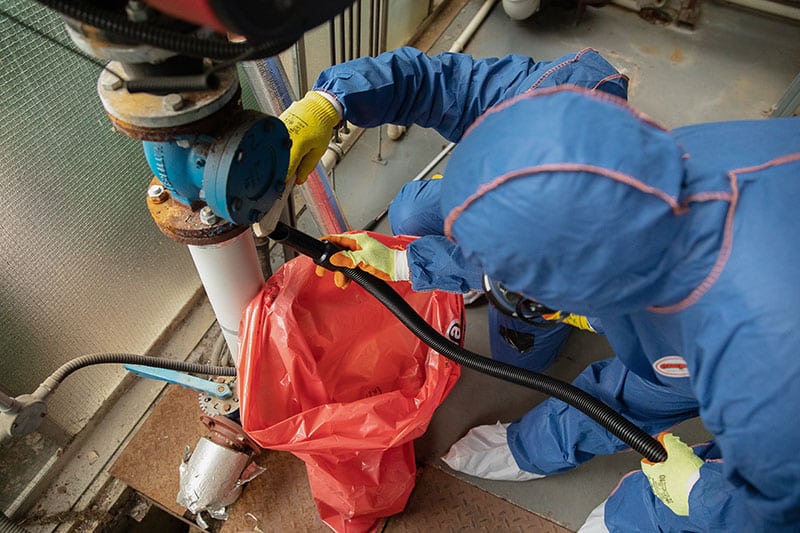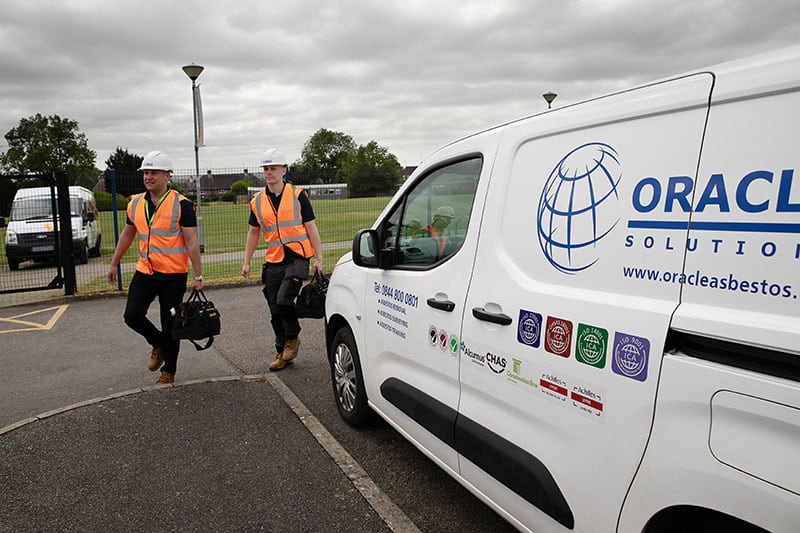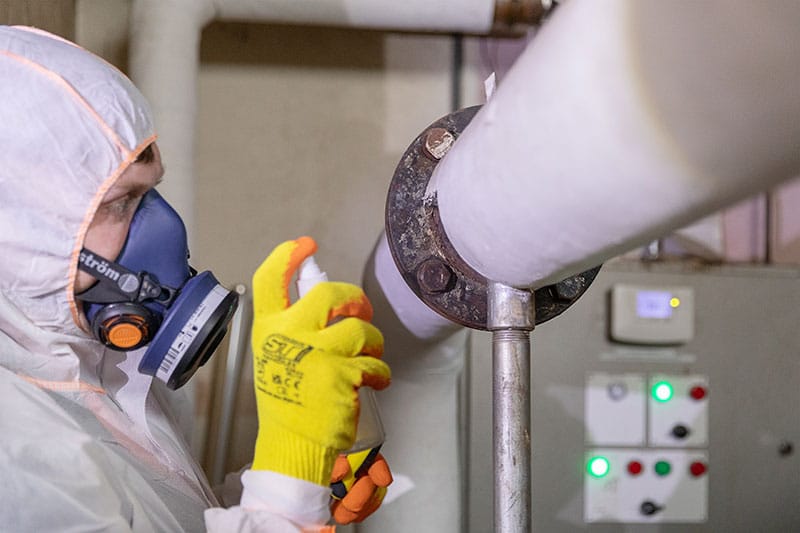Future considerations of asbestos removal in the UK
In the UK, there are over 5,000 asbestos-related deaths each year. Approximately 2,400 of these are due to mesothelioma, and there’s about the same number of asbestos-related lung cancers. Asbestosis is also to blame, making up about 500 annual deaths in the UK. According to the British Safety Council, “The current statistics reflect the legacy of past exposure to asbestos, and asbestos-related deaths are expected to continue at similar annual rates for more years to come.”
There’s a pressing need for asbestos removal in buildings throughout the UK. Moreover, tradespeople, as well as the public, need to be aware of the risks of asbestos and how to keep themselves safe. Unfortunately, with asbestos removal carrying such a high cost, combined with a lack of widespread knowledge about the true risks of asbestos, it’s proven difficult to manage asbestos as best as possible.

Historical asbestos use in the UK
The first known use of asbestos in the UK dates as far back as the 1870s, when it was used as insulation in power-generating plants, on ships, and in steam engines.
In the 1950s, it became a common component of construction in the UK, and that trend lasted until the 1980s. Because of its durability, fireproofing, and soundproofing qualities, it was a helpful addition to building materials.
This was before its dangers were widely known, though. While the risks of asbestos started to become clear in the early 1900s, it wasn’t banned in the UK until 1999.
The health risks of asbestos dust were known in the mid-1920s, and in response, the British government created regulations to control asbestos dust emissions. But it wasn’t until around the 1960s that people connected mesothelioma with asbestos and also realised that employees in asbestos factories were still at risk despite the regulations. The UK wouldn’t ban all forms of asbestos until three decades later.
Legislation surrounding asbestos removal in the UK
The Health and Safety Executive’s (HSE) Control of Asbestos Regulations 2012 was introduced in April 2012. The purpose of these rules is to reduce deaths from asbestos exposure and asbestos-related diseases. The Control of Asbestos Regulations 2012 provides a system for managing asbestos in buildings and controlling exposure events. It also puts the responsibility on the duty holder, who must assess asbestos on the property and make the proper decisions to either maintain or remove it.
Importance of professional asbestos removal services
Asbestos management companies handle all sorts of asbestos projects, including consulting with you before you start renovation or demolition work. Other services include:
- Surveys for the presence of asbestos
- Testing for asbestos
- Developing an asbestos management plan
- Planning an asbestos removal project
- Asbestos waste disposal
- Training employees on asbestos awareness
You may find our article about how to choose the right asbestos management company helpful if you’re in need of professional guidance.
Challenges and limitations in the asbestos removal industry
One of the major challenges the UK has faced regarding asbestos is that regulations had to evolve based on knowledge and technology. Before its dangers were known, asbestos was revered for its versatility for purposes including insulation, fire protection, and reinforcement. According to the British Safety Council, in 1964, the UK imported 187K tonnes of the material.
Another challenge of asbestos is how long it can take for exposure to impact a person’s health. Damaged asbestos releases fibres, which can then be inhaled. This can cause life-threatening diseases several decades in the future. That means that it can take as long as 40 years to get reliable health data about the impact of asbestos on some victims. Moreover, some people don’t know they’ve been exposed to asbestos at all. Its fibres are microscopic, and they can be breathed in without realising it.
Since asbestos poses a risk only when it’s damaged and the fibres are airborne, analysing asbestos-containing materials (ACMs) in a building is imperative to keeping everyone safe. Unfortunately, many building owners, who are legally required to manage asbestos on the premises, don’t want to spend the time or money on fulfilling their obligation.
Economic and environmental factors
According to a study from the early 2000s that examined 120 cases of asbestos-related diseases, mesothelioma made up 100 of the cases and cost Scottish National Health Service hospitals approximately £942,000. The greater UK figure for that year was more than £16,000,000. Adjusted for inflation, that’s nearly £29,000,000 today.
Compensation for victims of asbestos-related diseases and their families also has to be taken into consideration. In 2014, for example, £32 million was made available for victims of cancers caused by asbestos.
Economic impacts and environmental considerations of the asbestos removal industry
Managing asbestos comes with high costs, and failing to remove asbestos only worsens that. For example, consider what Parliament is spending on refurbishing the Palace of Westminster, which has a high risk of asbestos exposure.
Right now, the project is expected to cost £11 billion. However, if Parliament opts to operate out of the Palace while it’s being refurbished, costs will double to £22 billion, and renovations will take several years more.
While some people in the UK argue that any and all asbestos should be removed, the cost of total asbestos removal would be staggering. And even if there were a budget for it, there’s no assurance that 100% of the asbestos would be identified and safely removed. If it were to be left behind in a damaged state, it could continue releasing dangerous fibres.
Disposing of asbestos is difficult, too. According to the British Safety Council, “The number of landfill sites around the globe that accept asbestos has been significantly reduced.” That means there wouldn’t be enough space for proper asbestos disposal if it were to all be removed. When improperly disposed of, asbestos can impact air, soil, and water quality, posing a risk to the environment as well as people.
Sustainable practices and waste management
When it comes to disposing of asbestos waste in a responsible manner, the Control of Asbestos Regulations 2012 has guidelines to follow. According to HSE, asbestos waste has to be properly packaged to prevent fibres from releasing. Waste should first be wrapped in a red bag, and an asbestos warning label should be placed on it. Then, it should be wrapped again with a clear bag, and a label that states hazardous materials are inside should be placed on it.
If waste is too large for a bag, it should not be broken up. Any damage to ACMs can result in fibres being released and inhaled. Large ACMs should be wrapped twice with 1,000-gauge polythene sheeting and labelled.
Where asbestos waste is disposed of matters, too. As we talk about in our blog post about WAC testing, “Without the proper testing, the materials that go into the landfill can cause problems to the environment as well as human health and safety.” Only certain kinds of landfills can accept asbestos waste, so it’s important to dispose of it somewhere that’s able to handle it.
Public perception and awareness
Charities and organisations in the UK and beyond work to raise awareness about asbestos risks and prevention. Efforts like the Asbestos and You campaign from the HSE and Global Asbestos Awareness Week educate anyone who may be exposed to asbestos, particularly tradespeople, about its dangers. These programs also go into legal issues and asbestos training.
Since asbestos was banned over 20 years ago, some people may mistakenly think that they’re not at risk of an exposure event. However, there are many buildings across the UK that still have ACMs.
Buildings that were constructed prior to 1999 are likely to contain ACMs. While it’s the duty holder’s responsibility to manage asbestos on the premises, this doesn’t always happen. It’s also necessary for young tradespeople to understand the long-term risks of asbestos exposure so they can protect their future health.
Continued efforts are needed to ensure public safety
Thousands of people in the UK still die every year from asbestos-related complications. While the Control of Asbestos Regulations 2012 aims to aid duty holders in managing asbestos in their buildings, actually getting them to do so is a major challenge. If you think that asbestos may be on the premises and you’re not sure how to safely manage it, it’s best to hire a professional asbestos management company.
Asbestos removal isn’t inexpensive. However, the cost of a human life is much greater. Additionally, asbestos-related diseases can cost millions in medical bills and legal compensation. The best defences are asbestos awareness programs, safe removal practices, and leaving it in the hands of a professional when an asbestos project is too risky.
To promote a healthy, safe workplace, contact Oracle Solutions to discuss training for your staff, asbestos surveys, or asbestos removal services.

Written by Brendan Coleman
Brendan Coleman, with decades of experience in the asbestos industry, is a dedicated Quality Manager. Certified as a surveyor and analyst, he is adept in operations and quality management with a keen focus on HSE compliance. His expertise is pivotal in maintaining high safety and efficiency standards. Brendan ensures our UKAS accreditation requirements are consistently met and exceeded, upholding stringent standards in asbestos remediation. His commitment to enhancing quality and customer satisfaction makes him an essential advisor in asbestos management.


